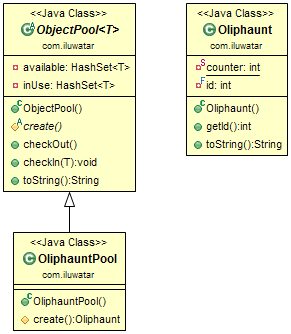| layout | title | folder | permalink | categories | tags | ||
|---|---|---|---|---|---|---|---|
pattern |
Object Pool |
object-pool |
/patterns/object-pool/ |
Creational |
|
When objects are expensive to create and they are needed only for short periods of time it is advantageous to utilize the Object Pool pattern. The Object Pool provides a cache for instantiated objects tracking which ones are in use and which are available.
Real world example
In our war game we need to use oliphaunts, massive and mythic beasts, but the problem is that they are extremely expensive to create. The solution is to create a pool of them, track which ones are in-use, and instead of disposing them re-use the instances.
In plain words
Object Pool manages a set of instances instead of creating and destroying them on demand.
Wikipedia says
The object pool pattern is a software creational design pattern that uses a set of initialized objects kept ready to use – a "pool" – rather than allocating and destroying them on demand.
Programmatic Example
Here's the basic Oliphaunt class. These are very expensive to create.
public class Oliphaunt {
private static AtomicInteger counter = new AtomicInteger(0);
private final int id;
public Oliphaunt() {
id = counter.incrementAndGet();
try {
Thread.sleep(1000);
} catch (InterruptedException e) {
e.printStackTrace();
}
}
public int getId() {
return id;
}
@Override
public String toString() {
return String.format("Oliphaunt id=%d", id);
}
}Next we present the Object Pool and more specifically Oliphaunt Pool.
public abstract class ObjectPool<T> {
private Set<T> available = new HashSet<>();
private Set<T> inUse = new HashSet<>();
protected abstract T create();
public synchronized T checkOut() {
if (available.isEmpty()) {
available.add(create());
}
var instance = available.iterator().next();
available.remove(instance);
inUse.add(instance);
return instance;
}
public synchronized void checkIn(T instance) {
inUse.remove(instance);
available.add(instance);
}
@Override
public synchronized String toString() {
return String.format("Pool available=%d inUse=%d", available.size(), inUse.size());
}
}
public class OliphauntPool extends ObjectPool<Oliphaunt> {
@Override
protected Oliphaunt create() {
return new Oliphaunt();
}
}And finally here's how we utilize the pool.
var pool = new OliphauntPool();
var oliphaunt1 = pool.checkOut();
var oliphaunt2 = pool.checkOut();
var oliphaunt3 = pool.checkOut();
pool.checkIn(oliphaunt1);
pool.checkIn(oliphaunt2);
var oliphaunt4 = pool.checkOut();
var oliphaunt5 = pool.checkOut();Use the Object Pool pattern when
- The objects are expensive to create (allocation cost)
- You need a large number of short-lived objects (memory fragmentation)
